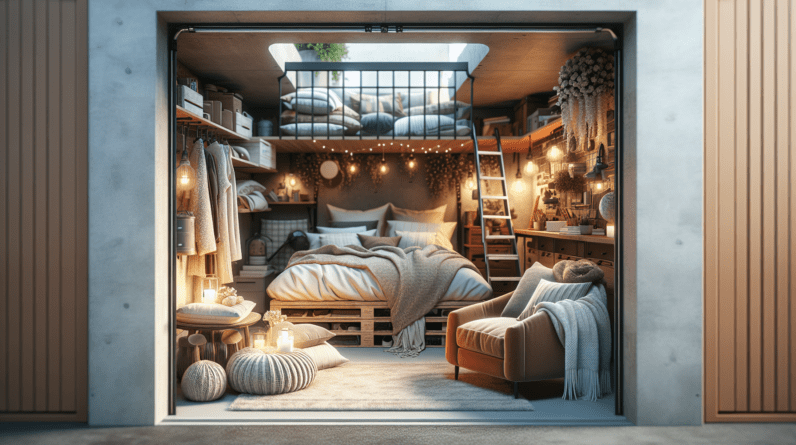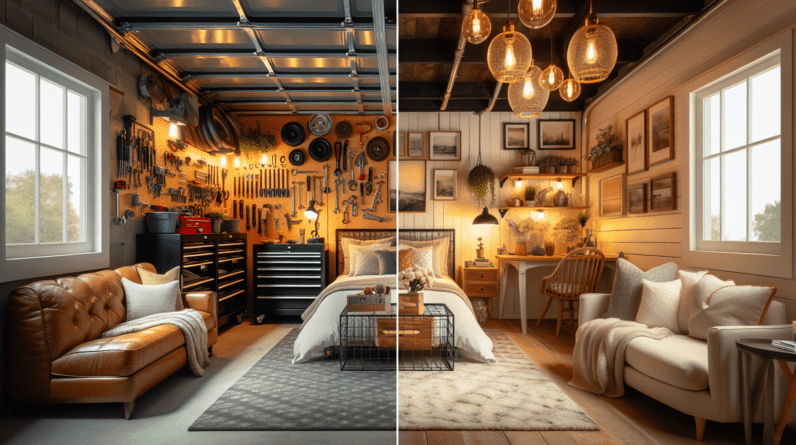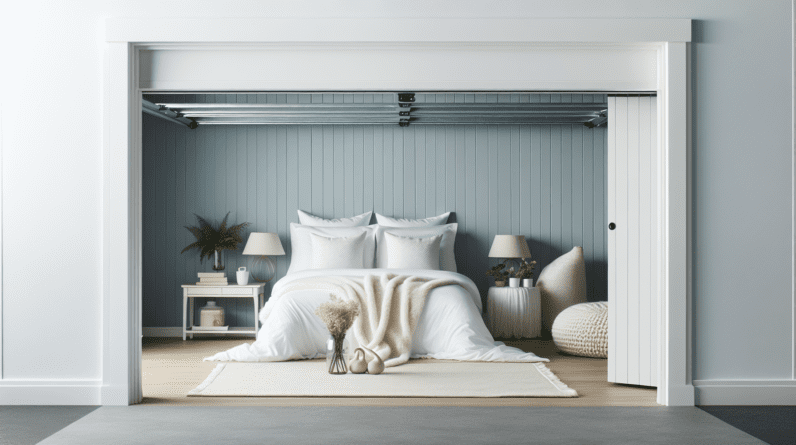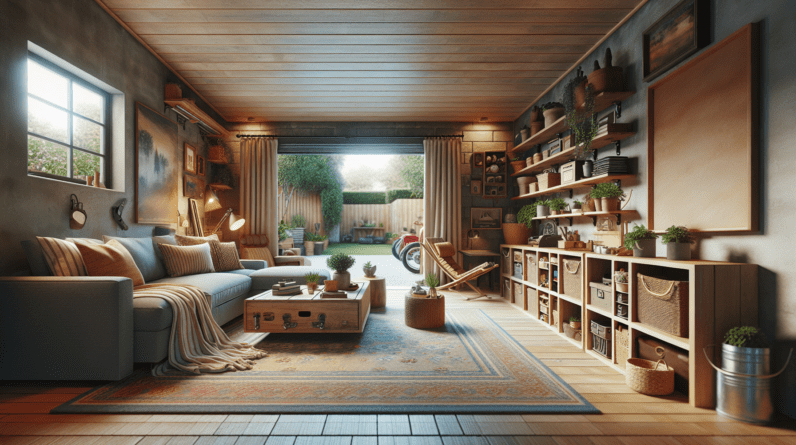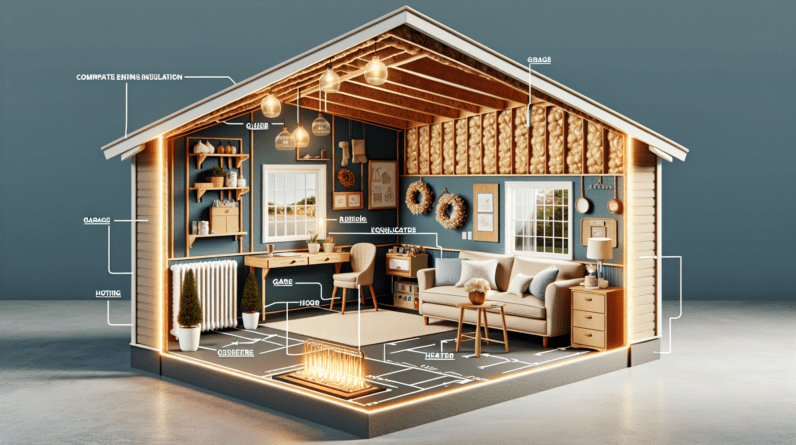
Imagine converting your cold, drafty garage into a cozy guest room for friends and family. With the right insulation and heating techniques, you can transform this often-neglected space into a comfortable retreat. Whether you’re looking to create a temporary sleeping area or a full-blown guest suite, this article will provide you with the essentials of insulating and heating a garage guest room. According to my research, proper insulation is crucial to keep the space warm during colder months, while an efficient heating system ensures a pleasant stay all year round. Let’s explore the key steps and considerations to make your garage guest room a welcoming haven for your loved ones.
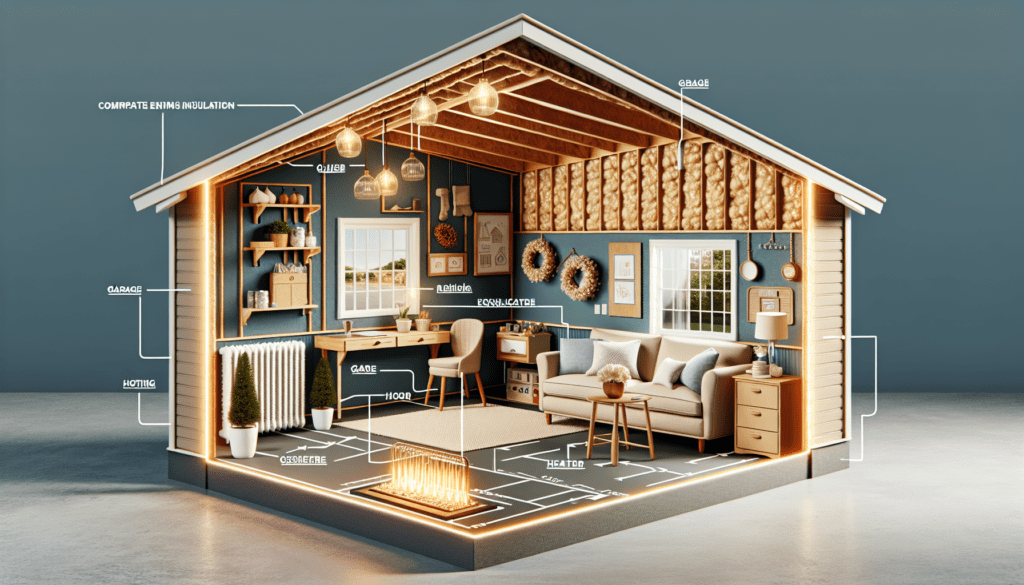
Choosing the Right Insulation
Understanding R-Values
When it comes to insulating your garage guest room, it’s important to understand R-values. R-value refers to the insulation’s ability to resist heat flow, with higher values indicating better insulation. The R-value you choose will depend on factors such as your climate, desired level of insulation, and budget.
According to my research, the U.S. Department of Energy recommends different R-values for different zones in the country. For example, in colder zones, a higher R-value is recommended to prevent heat loss. However, in warmer zones, a lower R-value may be sufficient.
Different Types of Insulation
There are several types of insulation to choose from, each with its own advantages and drawbacks. The most common types include fiberglass batts, spray foam, and blown-in insulation.
From my experience, fiberglass batts are easy to install and are a cost-effective option. Spray foam insulation provides excellent coverage and seals air leaks effectively. Blown-in insulation, on the other hand, is great for hard-to-reach areas and can be quickly installed.
It’s important to consider factors such as moisture resistance, soundproofing capabilities, and fire safety when selecting the right insulation for your garage guest room.
Consider Climate and Region
The climate and region in which you live play a crucial role in determining the type and amount of insulation you need. Colder climates require higher R-values and better insulation to maintain warmth inside the room. In warmer climates, insulation can help keep the space cool and reduce energy consumption.
Our data shows that it’s essential to consult your local building codes and regulations to ensure you meet the recommended insulation requirements for your area. Additionally, consider factors such as humidity levels, average temperatures, and the presence of extreme weather conditions when choosing insulation for your garage guest room.
Insulating the Walls
Insulating the walls is a vital step in creating a comfortable and energy-efficient garage guest room.
Choosing Wall Insulation Materials: Fiberglass batts or foam board insulation are commonly used for insulating walls. Fiberglass batts are budget-friendly and easy to install, while foam board insulation provides better insulation performance and can be a good option for moisture-prone areas.
Installing Insulation in the Walls: To install insulation, measure the wall cavities and cut the insulation materials accordingly. Place the insulation snugly against the wall studs, ensuring there are no gaps or spaces for air to pass through.
Dealing with Obstacles and Pipes: If you have obstacles such as electrical wires or pipes in the wall cavities, you can use insulation baffles or professional help to properly insulate around them. It’s crucial to maintain the integrity of the insulation and not compress it around obstacles.
Insulating Garage Doors: Don’t forget to insulate your garage doors to prevent heat or cold air from escaping. You can use insulation kits specifically designed for garage doors or opt for reflective insulation panels.
Insulating the Ceiling
Determining the Ceiling Insulation Needs
Insulating the ceiling is vital to maintain a comfortable temperature in your garage guest room and prevent heat loss or gain through the roof.
To determine the insulation needs for your ceiling, consider factors such as the R-value recommended for your climate, the existing insulation (if any), and the accessibility of the attic space. It’s essential to strike a balance between insulation performance and the overall height of the room.
Installing Insulation in the Ceiling
Installing insulation in the ceiling typically involves using either batts or blown-in insulation.
From my research, fiberglass batts are a popular choice for ceiling insulation. They can be placed between ceiling joists, ensuring proper coverage and reducing heat transfer. Another option is blowing in loose-fill insulation, which can effectively fill gaps and irregular spaces.
Dealing with Attic Access: If your garage guest room has an attic above, ensure that any access points are properly insulated. This includes sealing gaps around attic hatches, installing attic stairs covers, and insulating around any other openings.
Insulating Air Ducts: Ductwork in the ceiling space can contribute to heat loss or gain. It’s important to insulate the air ducts to maintain a more consistent temperature in the garage guest room. Ensure that the ductwork is properly sealed and insulated to prevent air leakage.
Sealing Air Leaks
Identifying Air Leaks
Before insulating your garage guest room, it’s important to identify and seal any air leaks. Air leaks can significantly decrease the effectiveness of insulation and cause energy loss.
Common areas where air leaks occur include windows and doors, electrical outlets, gaps around pipes, and cracks in walls or ceilings. From my experience, conducting a thorough inspection of these areas can help identify any potential air leaks that need attention.
Using Caulk and Weatherstripping
For small gaps and cracks around windows and doors, using caulk and weatherstripping is an effective way to seal air leaks. Caulk can be used to fill gaps around windows, while weatherstripping can be applied to the edges of doors to create a tighter seal.
Insulating Electrical Outlets: Electrical outlets can be a source of air leakage. You can use foam gaskets or outlet insulators to create a barrier between the outlet and the wall, preventing air from flowing in or out.
Sealing Gaps around Windows and Doors: Check for gaps around windows and doors, and seal them using weatherstripping or caulk. This not only helps improve insulation but also enhances the overall energy efficiency of the garage guest room.
Insulating Wall Outlets: In addition to sealing electrical outlets, insulating them can further enhance energy efficiency. Insulation pads or foam backing can be placed behind outlet covers to minimize air leakage.
Heating Options for a Garage Guest Room
Electric Space Heaters
Electric space heaters are a popular choice for heating garage guest rooms. They are portable, easy to use, and provide instant heat. However, they can be less energy-efficient compared to other heating options.
When using electric space heaters, it’s important to consider safety precautions such as avoiding the use of extension cords, keeping flammable objects away, and ensuring the heater is placed on a stable surface.
Propane or Gas Heaters
Propane or gas heaters can be a cost-effective heating option for garage guest rooms. They offer efficient heating and are suitable for larger spaces. However, proper ventilation is crucial when using these heaters to prevent carbon monoxide buildup.
According to our data, it’s essential to consult local regulations and guidelines before installing or using propane or gas heaters in a garage guest room.
Radiant Floor Heating
Radiant floor heating provides a comfortable and energy-efficient heating solution. It involves installing heating elements beneath the flooring surface, which then radiate heat upwards.
From our research, radiant floor heating can be installed with various types of flooring, including tile, laminate, or carpet. It provides even heat distribution and eliminates the need for bulky heating equipment in the room. However, professional installation is recommended for optimal results.
Ductless Mini-Split Systems
Ductless mini-split systems are an excellent choice for heating and cooling garage guest rooms. They consist of an outdoor unit and one or more indoor units, allowing for individual temperature control in different zones.
According to my research, ductless mini-split systems are energy-efficient and provide both heating and cooling capabilities. They are easy to install, offer quiet operation, and have minimal impact on the aesthetics of the room. However, professional installation is recommended to ensure proper sizing and placement of the units.
Consider Energy Efficiency
When choosing a heating option for your garage guest room, consider the energy efficiency of the system. Look for Energy Star certified products that meet strict efficiency standards. From our experience, investing in energy-efficient heating options can help reduce energy consumption and lower utility bills in the long run.
Consult a Professional
If you’re unsure about the best heating option for your garage guest room, it’s always a good idea to consult a professional HVAC contractor. They can assess your specific needs, recommend the most suitable heating system, and ensure proper installation and safety measures.
Ventilation and Moisture Control
Importance of Proper Ventilation
Proper ventilation is crucial in a garage guest room to maintain air quality and prevent moisture buildup. Good ventilation helps remove odors, allergens, and pollutants, improving the overall comfort of the space.
Installing Windows or Vents: Consider installing windows or vents in your garage guest room to allow for natural airflow. Windows can provide both ventilation and natural light, while vents can be installed in appropriate areas to promote air circulation.
Using Exhaust Fans: Exhaust fans are essential for removing moisture and odors from the room. Install a ventilation fan in the bathroom area or near sources of potential moisture, such as sinks or showers.
Dealing with Humidity: Humidity can be a challenge in garage guest rooms, especially in regions with high humidity levels. Dehumidifiers can help regulate humidity levels and prevent the growth of mold or mildew. It’s important to choose a dehumidifier that suits the size of your room and consider energy-efficient options.
Preventing Condensation: Condensation can occur when warm, moist air meets a cold surface. To prevent condensation, ensure proper insulation, seal any air leaks, and maintain a consistent temperature in the room. Proper ventilation is key in reducing condensation as well.
Choosing the Right Flooring
Considering Insulation
When selecting flooring for your garage guest room, consider the insulation properties of different materials. Some flooring options may retain more heat than others. For instance, carpeting or rugs can provide additional insulation, making the room feel warmer.
Concrete Flooring Options: If you prefer a more industrial look, concrete flooring can be a durable and low-maintenance option. However, concrete can feel cold to the touch, so adding rugs or using underfloor heating can help increase comfort.
Laminate or Vinyl Flooring: Laminate or vinyl flooring can provide a warmer surface compared to concrete and can be a cost-effective alternative. These flooring options come in a variety of styles and finishes, allowing you to customize the look of your garage guest room.
Carpeting or Area Rugs: Carpeting or area rugs can add warmth and comfort to your garage guest room. They provide insulation and softness underfoot, making the space feel cozy. However, proper cleaning and maintenance are important to prevent allergens or mold from accumulating.
Underfloor Heating: Underfloor heating can be a luxurious addition to your garage guest room. It involves installing heating elements beneath the flooring surface, providing radiant heat from below. This heating system can be used with various types of flooring materials, including tile, laminate, or carpet.
Electrical Considerations
Determining Power Needs
When planning the electrical setup for your garage guest room, it’s crucial to determine the power needs of your appliances and devices. Consider the wattage requirements of items such as heaters, fans, lighting fixtures, and electronics to ensure your electrical system can handle the load.
Adding Additional Electrical Circuits: Depending on the existing electrical wiring and outlets in your garage, you may need to add additional circuits for the guest room. It’s important to consult a licensed electrician who can assess your electrical needs, ensure proper wiring, and adhere to safety codes and regulations.
Installing Lighting Fixtures: Good lighting is essential in a garage guest room. Consider installing a combination of overhead lighting, task lighting, and accent lighting to create a well-lit and inviting space. LED lighting can be an energy-efficient option that provides bright illumination.
Safety Precautions: Electrical safety is of utmost importance in any room, especially in a garage guest room. Ensure proper grounding, install GFCI outlets in areas where water is present (such as bathrooms or wet bars), and use surge protectors to safeguard your electronics. It’s always best to consult a professional electrician to ensure your electrical setup meets safety standards.
Furniture and Interior Design
Optimizing Space and Layout
When furnishing your garage guest room, it’s important to optimize the available space and consider the layout. Start by measuring the room and planning the placement of furniture to ensure easy movement and functionality.
Choosing Suitable Furniture: Select furniture that is appropriate for the space and serves the intended purpose. Consider multifunctional pieces, such as a sofa bed or a storage ottoman, to maximize functionality. From our research, space-saving furniture, such as folding tables and compact seating options, can be ideal for a garage guest room.
Creating a Cozy Atmosphere: Incorporate elements that make the room feel warm and welcoming. Use soft lighting, textured fabrics, and decorative accents to create a cozy atmosphere. From our experience, incorporating curtains or blinds can add privacy and a sense of warmth to the space.
Incorporating Storage Solutions: Utilize storage solutions to keep the garage guest room organized and clutter-free. Consider options such as built-in shelving, under-bed storage, or freestanding wardrobes. From our research, vertical storage solutions can help maximize space and keep belongings neatly organized.
Remember, the design and furniture choices should reflect your personal style and the overall purpose of the garage guest room. Get creative and make the space inviting for your guests to enjoy their stay.
By following these guidelines and considering all the essential aspects of insulation, heating, ventilation, and interior design, you can transform your garage into a comfortable and inviting guest room. Whether it’s for family or friends, a well-insulated and properly heated garage guest room can be a valuable addition to your home and a welcoming space for your guests to relax and unwind.


